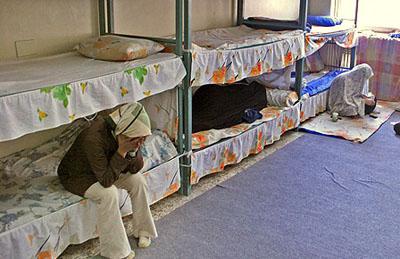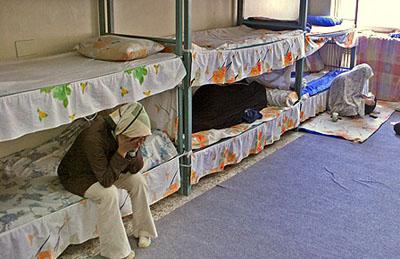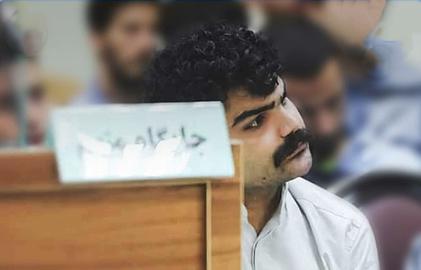
“I’m distraught not for myself but for the girls who are raped before they are executed,” Mother Naimi declared from prison, just prior to her execution. She had known virgin girls who had been raped and then killed. A few weeks later, Mother Naimi herself faced the firing squad after she refused to cooperate with Asadollah Lajevardi, warden of the Evin prison at the time.
Shirin Nariman, a supporter of People’s Mojahedin Organisation, remembers Akram Naimi, her former cellblock mate.
It was January 1982. “That day, Farzaneh Nourbakhsh, the manager of cell block 242 for women, got on the PA system and ordered people to come and move Akram Naimi to the cell block. Mother Naimi was unable to walk so a few of us helped her down the stairs. When we moved her chador aside, her feet were very red and inflamed, as though they had been dipped into hot oil. Her full name and a date, written with a thick magic marker, were visible on her feet.”
Justice For Iran has published a report on the organised rape of virgin girls awaiting execution in Iranian prisons, focusing specifically on the 1980s. According to the report, “In a six-month period between June 20, 1981 and 21 December of the same year, at least 2,241 people were executed, of which 223 were women.” It goes on to say: “ Of these women, 34 or about 15% were under 18 years old, while 120, close to 54%, were between 18 and 29.”
Crime without punishment
The only Islamic Republic leader who came out against executions was Hussein-Ali Montazeri, who at the time was the designated successor to Ayatollah Khomeini. He asked, in a letter to Khomeini in November 1986: “Do you know that in some of the Islamic Republic prisons, young girls have been violated by force? Do you know that when the girls are interrogated, foul and dishonorable words are used regularly?”
Eventually, he was removed from his position and was placed under house arrest for years.
“Crime without punishment” is how Shadi Sadr, writer, woman’s rights activist and Director of Justice For Iran, described her human rights foundation’s report in an interview with IranWire.
The report is published in two parts, the first reporting on the 1980s and the second on the subsequent two decades. Investigators and experts working for Justice for Iran refute widespread denials that, in Iran, girls were the victims of rape before execution.
When asked about the “forced marriage”of virgin girls before their executions in the summer of 1987, the website Students’ Issues, run by the office of the Iranian Supreme Leader, gave the following answer: “The ban on the execution of girls unless they are married is a rumour spread by enemies to whitewash their own crimes and treasons against the country and to damage the reputation of the Islamic system.”
Forcing virgins to become concubines and raping them before execution, the answer went on to say, is a false claim by the “counter revolution” and a baseless impression extrapoloted from the correspondence of Ayatollah Montazeri.
“This is the first time in the past decade,” Shadi Sadr says, “that a government official publicly reacts to the accusations of raping virgins before they were executed. Of course it was in the form of a denial, even though the records and the evidence leave no doubt that these crimes were committed. This is why the UN’s Special Report on Violence Against Women, a report by an independent entity, has confirmed them.”
The evidence presented and documented by the Justice in Iran report includes the following testimonies:
“Some prisoners who were provided a ballpoint pen to write their will used it to write on their own clothing or body that they had been raped.” (Elaheh Deknama, prisoner in Shiraz, and Sima Mottalebi, prisoner in Mashhad)
“Some families saw the signs of rape on the bodies of their executed daughters.” (Mahnaz Yousefzadeh)
“In some other cases, a member of the Revolutionary Guards came to the family’s door and offered them a symbolic dowry: A box of candies” (Shaheen Sami in the port of Anzali, Mitra and Mandana Mojaverian in Mashhad) “or a few ceremonial coins” (Fariba Ahmadi, prisoner in Isfahan).
“Read punishment verses!”
Iraj Mesdaghi, a human rights activist who spent from 1981 to 1991 in various prisons around the country, writes in his book, Hell On Earth: Ghezelhessar Prison, that Khomeini went so far as to say that, although prayers and fasting are religious obligations, “Islamic commandments are not limited to these...why don’t you read [Koranic] verses on punishment? You only read verses on mercy! Those 59 verses on punishment are merciful too because they want to shape the right human.”
When Mehdi Karroubi, speaker of the parliament, asked President Rafsanjani to investigate accusations of prison rapes, Majid Ansari, then (and now again) vice president for parliamentary affairs, told the Islamic Republic News Agency (IRNA) that “unfortunately they are true and...one should wish for death that the Islamic Republic has reached a point where such scandals are possible...It happened not once, but many times.”
We asked Shadi Sadr if Justice For Iran can estimate how many women were raped before execution. She said this was impossible: “No human rights group can give you statistics or even an estimate without getting access to the archives of Revolutionary Courts and conducting interviews with the officials responsible for running the courts at the time. Moreover, none of the victims of such tortures are alive to give testimony.”
The number of girls or women who were raped in prison is also not known. Though many victims of sexual torture, including rape, survived the ordeal, putting a number on it is a formidable challenge for a variety of reasons. The most important of them is the high number people in prison during the 1980s.
Despite this, Justice for Iran’s investigations prove that this practice was used regularly and systematically, at least for a period of time and especially in prisons in Mashhad, Shiraz and Rasht.
According to Sadr, the proof lies in testimonies from numerous female political prisoners and the families of victims who received a sort of “dowry” from Revolutionary Guards. The memoirs of Ayatollah Montazeri also provide evidence, as do religious texts used at the time to support the practice.
Sadr and her colleagues insist they were not necessarily looking for numbers or statistics when they started their investigations into the history of sexual violence against female prisoners. For Justice for Iran, it was important to identify who the leaders and perpetrators were; it was important to document the patterns and types of torture.
The organisation was successful in securing close to 100 interviews with former female prisoners, hoping to discover what types of violence and torture were systematic or pervasive. Although a considerable number of political prisoners from the 1980s and 1990s have left Iran, most of them still live in the country. But, for security reasons, access to them is very problematic.
“You can’t expect statistics and quantity from a qualitative investigation,” cautions the director of Justice for Iran. “What was essential was to interview all women who had experienced at least one type of sexual torture and violence, or often more.”
No Preferential Treatment
Sadr emphasises that in prisons in the 1980s, women were given no preferential treatment. “If men were whipped with cables, so were women. On the contrary, because of their sex, women suffered from double cruelty, from sexual insults to physical torture.” During this time, forced marriage was commonly used against women prisoners. “Even now,” Sadr adds, “the use of sexual insults continues and is widespread.”
Reynaldo Galindo Pohl, the United Nation’s special envoy for investigating human rights in Iran, reported that prison officials presented marriage documents to the families of young female members of People’s Mojahedin Organisation. This suggests that these women were, in most cases, raped before execution.
Shadi Sadr and her colleagues talked to prisoners whose newborn babies or young children stayed with them during their time in prison. Many of these imprisoned mothers were the victims of some of the worst violence documented. Their children suffered extreme torture and were deprived of basic necessities such as food, medication and clothing. In some cases, children were imprisoned as hostages.
Shadi Sadr personally investigated one of the worst cases of cruelty the organisation documented, that of Samieh Taghavaee. After conducting several interviews and reviewing evidence, she came across a crime that even she could not believe at first.
The 9-year-old Samieh was doing her homework when Revolutionary Guards broke into her home, looking for her parents. When they didn’t find them, they arrested Samieh and took her to Evin prison. They kept her in prison and, for five years, until she was 14, they repeatedly interrogated her to find out where the parents could possibly be hiding.
She witnessed the whippings and the torture of other prisoners in the prosecution chambers at Evin. Because she was so small, she was put to work in the sewing workshop. As a result of anxiety and psychological pressures, she suffered from enuresis, involuntary urination at night.
She was released from Evin at aged 18, but was forced to marry somebody affiliated with the government because judiciary officials threatened that they would return her to prison if she refused. When she was only 25, and a mother of two children, she died of cancer. No one ever claimed responsibility for destroying her life.
UN recognition
The United Nations has now, for the first time, recognised that virgin women and girls were raped in Iranian prisons before being executed during the 1980s. Shadi Sadr believes that families of the victims must also use other UN mechanisms, such as special reports, to confront the Islamic Republic, which must be held accountable in a public and official arena.
Iran is a member of both the UN Convention Against Torture and the UN Convention for Elimination of All Forms of Discrimination Against Women. These conventions, however, are not effective tools for submitting complaints or for pursuing them directly at an international level — but other mechanisms can be used.
For now, Shadi Sadr’s Justice For Iran is hopeful that at least some of the perpetrators of and responsible for these crimes can be put on trial in other countries, especially if they are responsible for torture, murder and forced disappearances. She believes that the principle of “universal jurisdiction” can be used to prosecute those who raped virgins before executing them, and those who allowed it to happen.
Thinking of the victims of that time, a decade of sorrow for the dissidents who were wiped out with a bullet or a rope, continues to be painful for Iran’s collective memory. And still, the mysteries surrounding those very real massacres persist.
visit the accountability section
In this section of Iran Wire, you can contact the officials and launch your campaign for various problems

























comments
I remember reading Roya Hakakian's memoir, and her book was dedicated to these women. Human tragedies make you pause and think.